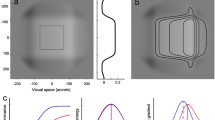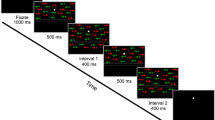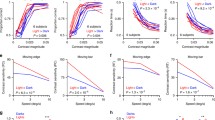Abstract
We sought to determine the extent to which colour (and luminance) signals contribute towards the visuomotor localization of targets. To do so we exploited the movement-related illusory displacement a small stationary window undergoes when it has a continuously moving carrier grating behind it. We used drifting (1.0–4.2 Hz) red/green-modulated isoluminant gratings or yellow/black luminance-modulated gratings as carriers, each curtailed in space by a stationary, two-dimensional window. After each trial, the perceived location of the window was recorded with reference to an on-screen ruler (perceptual task) or the on-screen touch of a ballistic pointing movement made without visual feedback (visuomotor task). Our results showed that the perceptual displacement measures were similar for each stimulus type and weakly dependent on stimulus drift rate. However, while the visuomotor displacement measures were similar for each stimulus type at low drift rates (<4 Hz), they were significantly larger for luminance than colour stimuli at high drift rates (>4 Hz). We show that the latter cannot be attributed to differences in perceived speed between stimulus types. We assume, therefore, that our visuomotor localization judgements were more susceptible to the (carrier) motion of luminance patterns than colour patterns. We suggest that, far from being detrimental, this susceptibility may indicate the operation of mechanisms designed to counter the temporal asynchrony between perceptual experiences and the physical changes in the environment that give rise to them. We propose that perceptual localisation is equally supported by both colour and luminance signals but that visuomotor localisation is predominantly supported by luminance signals. We discuss the neural pathways that may be involved with visuomotor localization.






Similar content being viewed by others
References
Anderson SJ, Yamagishi N (2000) Spatial localization of colour and luminance stimuli in human peripheral vision. Vision Res 40:759–771
Anstis S, Ramachandran VS (1995) At the edge of movement. In: Gregory R, Harris J, Heard P, Rose D (eds) The artful eye. Oxford University Press, Oxford, pp 232–248
Ashida H (2004) Action-specific extrapolation of target motion in human visual system. Neuropsychologia 42:1515–1524
Bar M, Tootell RB, Schacter DL, Greve DN, Fischl B, Mendola JD, Rosen BR, Dale AM (2001) Cortical mechanisms specific to explicit visual object recognition. Neuron 29:529–535
Bruno N (2001) When does action resist visual illusions? Trends Cogn Sci 5:379–382
Buneo CA, Andersen RA (2006) The posterior parietal cortex: sensorimotor interface for the planning and online control of visually guided movements. Neuropsychologia 44:2594–2606
Burr DC, Morrone MC, Ross J (2001) Separate visual representations for perception and action revealed by saccadic eye movements. Curr Biol 11:798–802
Carey DP (2001) Do action systems resist visual illusions? Trends Cogn Sci 5:109–113
Cavanagh P, Tyler CW, Favreau OE (1984) Perceived velocity of moving chromatic gratings. J Opt Soc Am A 1:893–899
De Valois RL, De Valois KK (1991) Vernier acuity with stationary moving Gabors. Vision Res 31:1619–1626
Dyde RT, Milner AD (2002) Two illusions of perceived orientation: one fools all of the people some of the time; the other fools all of the people all of the time. Exp Brain Res 144:518–527
Efron B, Tibshirani RJ (1993) An introduction to the bootstrap. Chapman & Hall, New York
Flitcroft DI (1989) The interactions between chromatic aberration, defocus and stimulus chromaticity: implications for visual physiology and colorimetry. Vision Res 29:349–360
Fredericksen RE, Bex PJ, Verstraten FA (1997) How big is a Gabor patch, and why should we care? J Opt Soc Am A 14:1–12
Gegenfurtner KR, Hawken MJ (1996) Interaction of motion and color in the visual pathways. Trends Neurosci 19:394–401
Gegenfurtner KR, Kiper DC (2003) Color vision. Annu Rev Neurosci 26:181–206
Gegenfurtner KR, Rieger J (2000) Sensory and cognitive contributions of color to the recognition of natural scenes. Curr Biol 10:805–808
Goodale MA, Milner AD (1992) Separate visual pathways for perception and action. Trends Neurosci 15:20–25
Grill-Spector K (2003) The neural basis of object perception. Curr Opin Neurobiol 13:159–166
Hendry SH, Reid RC (2000) The koniocellular pathway in primate vision. Annu Rev Neurosci 23:127–153
Hu Y, Eagleson R, Goodale MA (1999) The effects of delay on the kinematics of grasping. Exp Brain Res 126:109–116
Kerzel D, Gegenfurtner KR (2005) Motion-induced illusory displacement reexamined: differences between perception and action? Exp Brain Res 162:191–201
Kingdom FA (2003) Color brings relief to human vision. Nat Neurosci 6:641–644
Kingdom FA, Beauce C, Hunter L (2004) Colour vision brings clarity to shadows. Perception 33:907–914
Levitt H (1971) Transformed up-down methods in psychoacoustics. J Acoust Soc Am 49:467–477
Liu JV, Ashida H, Smith AT, Wandell BA (2006) Assessment of stimulus-induced changes in human v1 visual field maps. J Neurophysiol 96:3398–3408
Livingstone M, Hubel D (1988) Segregation of form, color, movement, and depth: anatomy, physiology, and perception. Science 240:740–749
Maunsell JH, Nealey TA, DePriest DD (1990) Magnocellular and parvocellular contributions to responses in the middle temporal visual area (MT) of the macaque monkey. J Neurosci 10:3323–3334
Merigan WH, Maunsell JH (1993) How parallel are the primate visual pathways? Annu Rev Neurosci 16:369–402
Milner D, Goodale MA (1995) The visual brain in action. Oxford University Press, Oxford
Mollon JD (1989) “Tho’ she kneel’d in that place where they grew...” The uses and origins of primate colour vision. J Exp Biol 146:21–38
Mollon JD (1991) Uses and evolutionary origins of primate colour vision. In: Cronly-Dillon JR, Gregory RL (eds) Evolution of the eye and visual system. Macmillan, London, pp 306–319
Mullen KT, Yoshizawa T, Baker CL Jr (2003) Luminance mechanisms mediate the motion of red-green isoluminant gratings: the role of “temporal chromatic aberration”. Vision Res 43:1235–1247
Nijhawan R (1994) Motion extrapolation in catching. Nature 370:256–257
Osorio D, Vorobyev M (1996) Colour vision as an adaptation to frugivory in primates. Proc R Soc Lond B Biol Sci 263:593–599
Payton ME, Greenstone MH, Schenker N (2003) Overlapping confidence intervals or standard error intervals: What do they mean in terms of statistical significance? J Insect Sci 3:34 (6 pp) Epub: http://www.insectscience.org/3.34/
Ramachandran VS, Anstis SM (1990) Illusory displacement of equiluminous kinetic edges. Perception 19:611–616
Schiller PH, Logothetis NK, Charles ER (1990) Functions of the colour-opponent and broad-band channels of the visual system. Nature 343:68–70
Sumner P, Mollon JD (2000) Chromaticity as a signal of ripeness in fruits taken by primates. J Exp Biol 203:1987–2000
Tanaka K, Saito H, Fukada Y, Moriya M (1991) Coding visual images of objects in the inferotemporal cortex of the macaque monkey. J Neurophysiol 66:170–189
Troscianko T, Fahle M (1988) Why do isoluminant stimuli appear slower? J Opt Soc Am A 5:871–880
Ungerleider LG, Mishkin M (1982) Two cortical visual systems. In: Ingle DJ, Goodale] MA, Mansfield RJW (eds) Analysis of visual behavior. MIT Press, Cambridge, pp 549–586
White BJ, Kerzel D, Gegenfurtner KR (2006) Visually guided movements to color targets. Exp Brain Res 175:110–126
Whitney D, Goltz HC, Thomas CG, Gati JS, Menon RS, Goodale MA (2003) Flexible retinotopy: motion-dependent position coding in the visual cortex. Science 302:878–881
Willis A, Anderson SJ (1998) Separate colour-opponent mechanisms underlie the detection and discrimination of moving chromatic targets. Proc R Soc Lond B Biol Sci 265:2435–2441
Willis A, Anderson SJ (2002) Colour and luminance interactions in the visual perception of motion. Proc R Soc Lond B Biol Sci 269:1011–1016
Yamagishi N, Anderson SJ, Ashida H (2001) Evidence for dissociation between the perceptual and visuomotor systems in humans. Proc R Soc Lond B Biol Sci 268:973–977
Acknowledgments
This research was supported by the 21st Century COE program (D-10 to Kyoto University), MEXT, Japan; NICT; and JSPS Grants-in-Aid for Scientific Research (17200019, 18203036).
Author information
Authors and Affiliations
Corresponding author
Rights and permissions
About this article
Cite this article
Ashida, H., Yamagishi, N. & Anderson, S.J. The relative contributions of colour and luminance signals towards the visuomotor localisation of targets in human peripheral vision. Exp Brain Res 183, 425–434 (2007). https://doi.org/10.1007/s00221-007-1059-0
Received:
Accepted:
Published:
Issue Date:
DOI: https://doi.org/10.1007/s00221-007-1059-0




